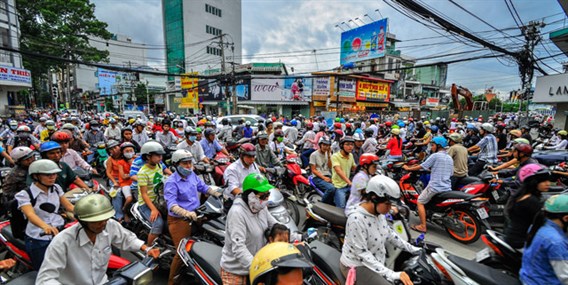-
In a recent conversation with the CEO of one of Vietnam's hypermarkets, he told me when they opened their first such huge store he didn’t realise the average spend per customer would be so low.
When he looked into why the spend was so low, he quickly realised it was because more than 95 per cent of customers came to the supermarket on their motorbikes. There was only so much the consumer could carry on their motorbikes – even considering the amazing loads Vietnamese can stack on their bikes.
McDonalds got it dead right when they set up a 'drive thru' dedicated for motorbikes for their first two stores in Vietnam.

The “motorbike dynamic” highlighted the particular thinking required by retailers when approaching Vietnam's market.
Being the 14th most populous country in the world, with growing urbanisation and a young population (50 per cent are below the age of 35), the rise of the Vietnamese consumer is attracting the attention of foreign and local retailers.
From a local investor perspective, we have seen significant growth in retailers in clothing (such as Blue Exchange), electronics (Nguyen Kim, Mobile World and FPT) and coffee (Trung Nguyen).
Foreign investors are also entering the market with AEON from Japan opening its first mall while Starbucks has seven outlets and M&S have just announced the opening of their first store.
The opportunity is indeed large but, as the motorbike dynamic shows, there are some Vietnamese idiosyncracies at play. Some of the common themes that come across from discussions with various local and foreign Retail leaders are:
- Time Horizon
Be flexible with your return on investment. One fast food chain has increased its business plan from a three year to an eight year return. A Mall operator has a ROI horizon of 10 years - something many listed companies may struggle with.
- Cash is King
Over 95 per cent of the transactions, even in the most advanced stores, are cash. Credit card penetration is growing but from a very small base (3 per cent penetration) and consumers have not got used to the idea of using a debit card for day to day shopping. Even in the auto-sector, less than 10 per cent of cars are purchased with credit.
- Wet Market to Mall to Digital
The ready mix of shopping experiences have spoilt the Vietnamese consumer. The ability to enjoy the street life of wet markets, the comfort of a mall or the convenience of digital will only serve to spread the growth of the Vietnamese consumer. For someone like me who loves 'street life', one can only hope that the Mall culture doesn't come at the expense of the wet market. At present it doesn't look likely.
We can see the growth of online spending through our own ANZ Credit Card business. Overall spending online is growing at 35 per cent year on year. Again, it is off a small base but in a few years this will become very meaningful.
- Location Discovery
This appears to be a specific pain point, especially for retailers looking to expand into Hanoi. Finding the right building, in the right location at the right price appears to stretch the patience of most retailers. This is something that will evolve (as people get used to the negotiation process) but at present it does cause clear frustration to many looking to expand.
So where are the second Cities?
After Hanoi and Ho Chi Minh, the growth of cities such as Hai Phong, Danang and Can Tho has clearly allowed them to establish themselves as contenders. Ho Chi Minh has “satellite” centres such as Dong Nai and Binh Duong - large export related manufacturing hubs which are also fast growing. However, it is clear that more centres will evolve as the level of urbanisation continues to grow.The mood of the consumer has proved to be a major driver of behaviour. We have seen the Vietnamese consumer display a fairly volatile mood over the past seven months. The ANZ Roy Morgan Consumer Confidence Index demonstrates this.

The impact of a maritime dispute with China and ongoing State Owned Enterprise restructuring clearly impacted the first five months of the year. However, June has seen confidence return and only time will tell if this return sustains itself over the coming months.
This volatility and these diverse market factors are part of why it is such a fascinating and rapidly evolving environment in Vietnam. Having spent time in Vietnam for over 21 years, I can't help but be infected by the energy, growth and cultural richness of the country.
In recent years, what has driven this is exports mostly to the consumers in the US and Europe. In years to come though, another key driver will be the blossoming of the Vietnamese consumer.
The views and opinions expressed in this communication are those of the author and may not necessarily state or reflect those of ANZ.
- Time Horizon
anzcomau:Bluenotes/global-economy,anzcomau:Bluenotes/global-economy/growth
Vietnamese supermarkets restrained by bikie culture
2014-08-07
